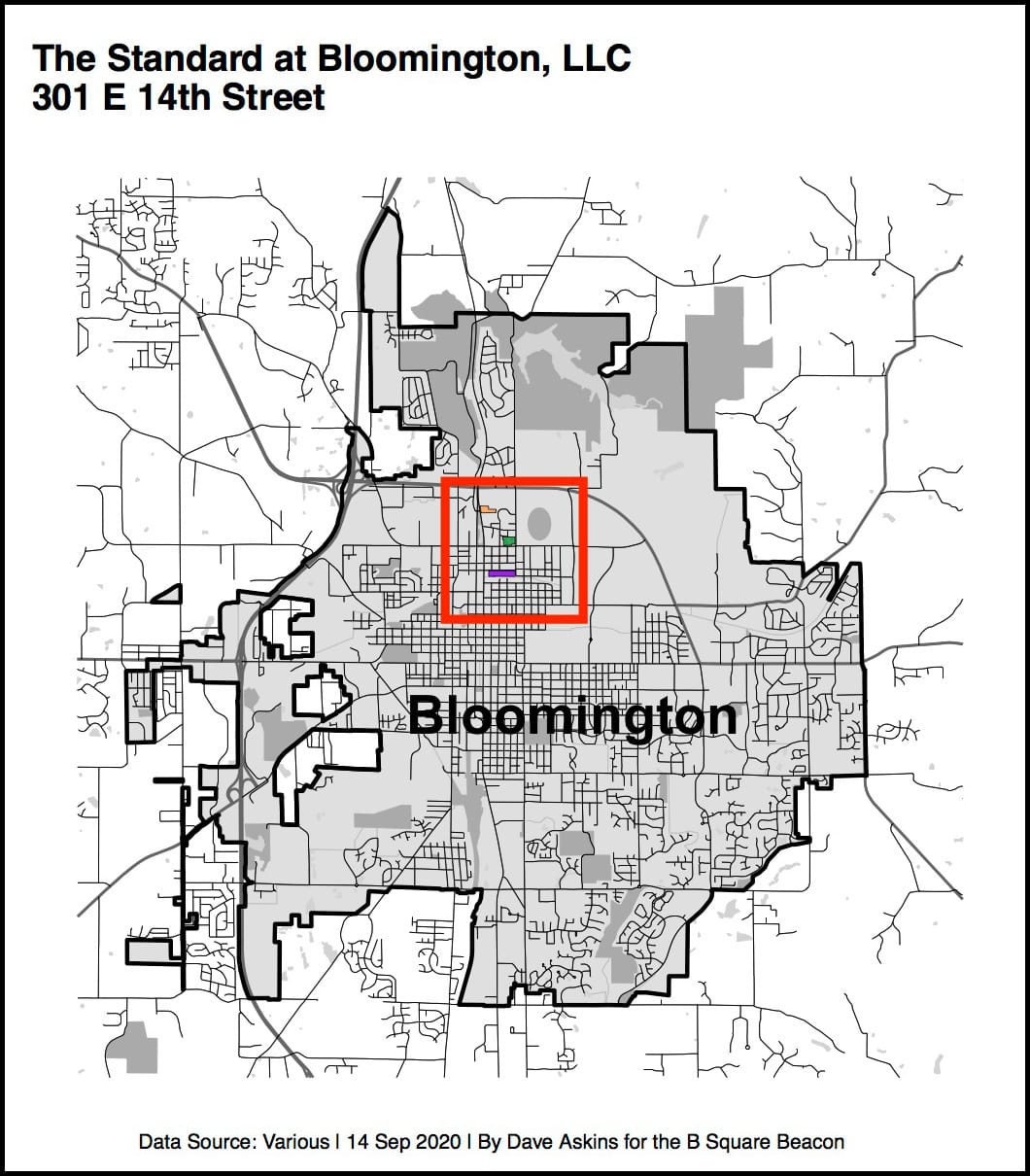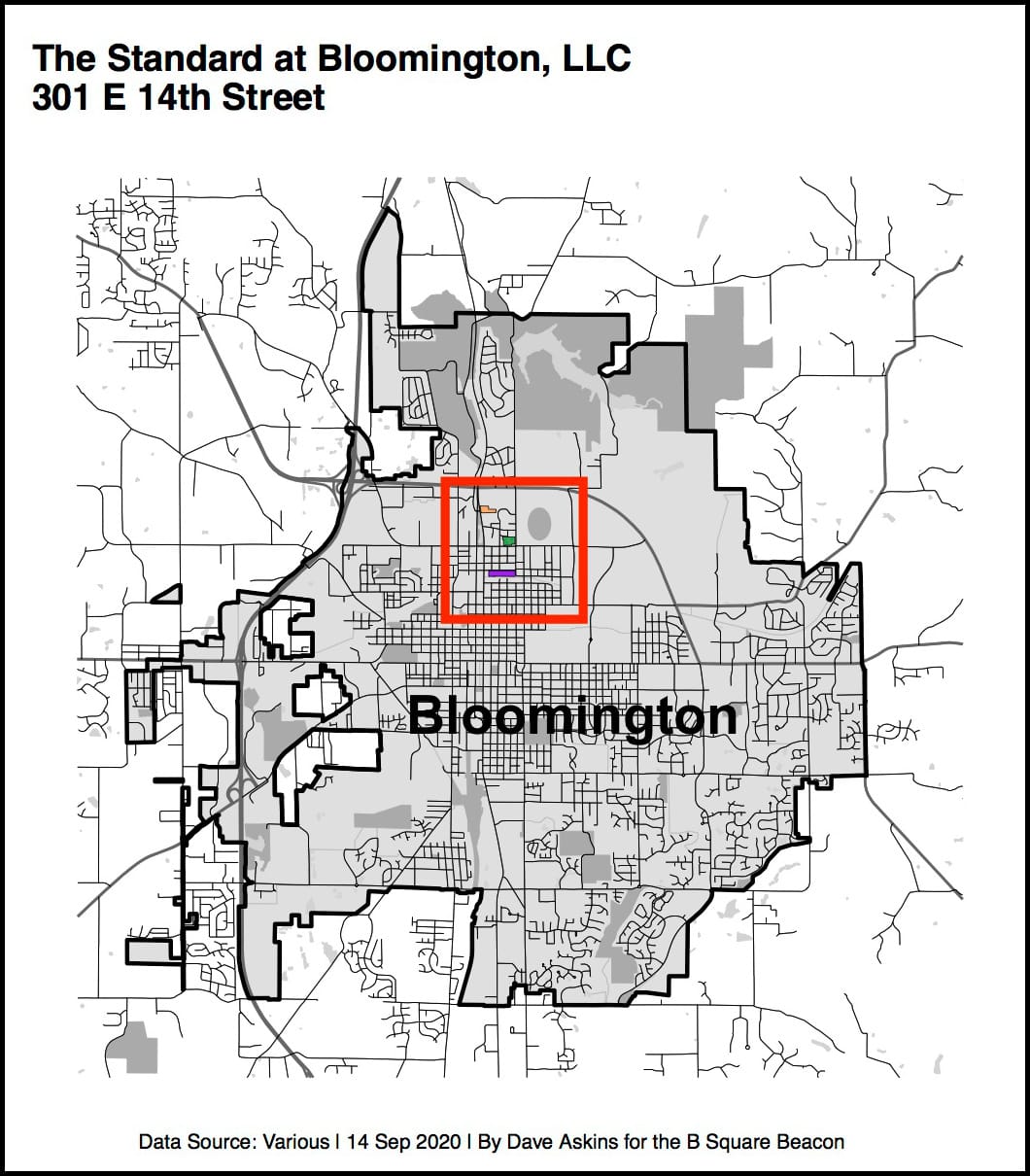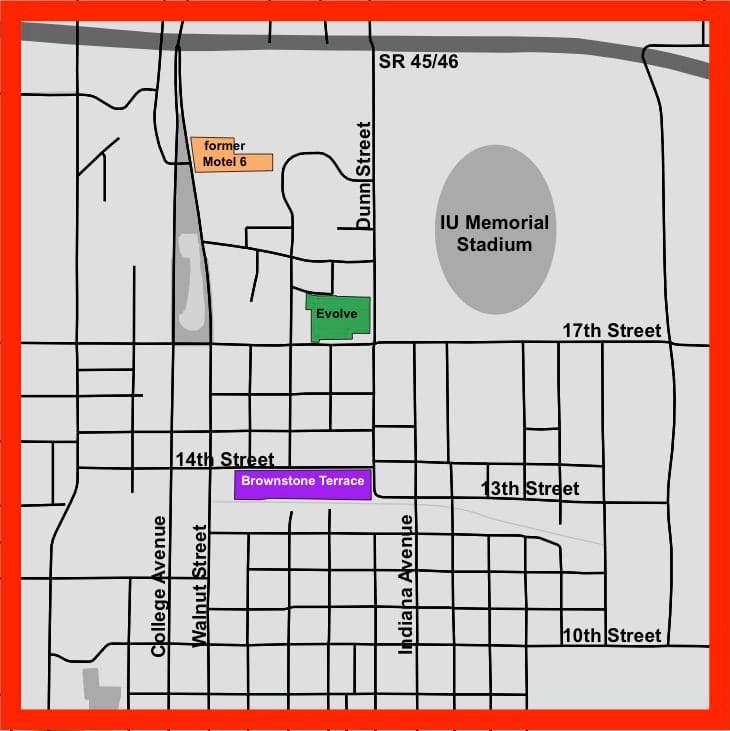Bloomington plan commission gives rezoning for student housing a standard second hearing



A commonly known connection between Bloomington, Indiana, and Athens, Georgia is based on the 1979 movie “Breaking Away.” The film was shot in Bloomington, where both the movie and short-lived TV series were set. The TV series was shot in Athens.
A second connection between the two small cities was highlighted at Monday night’s meeting of Bloomington’s plan commission. The new property developer for the predominantly student-rented Brownstone Terrace, who wants to demolish the complex and build a new, bigger student-oriented housing in its place, is Landmark Properties, based in Athens.
Landmark Properties develops student housing under its brand, “The Standard.” The owner’s name on the property records is The Standard at Bloomington.
On Monday night, plan commissioners got a formal introduction to the request from The Standard to rezone the property from planned unit development (PUD) to a new zoning classification in the recently adopted unified development ordinance (UDO), which is multi-use student housing (MS).
The plan commission’s reaction to the proposal seemed neutral to somewhat favorable. After giving the request less than an hour of deliberations, no action was taken except to move the rezoning request along to a second hearing. That was planning staff’s recommendation.
The second hearing will take place at the plan commission’s regular second-Monday monthly meeting on Oct. 12. The question in front of the plan commission is whether to grant the rezoning request, not to approve the site plan—even if some the presentation includes the kind of detailed renderings often associated with site plan presentations.
The Standard would demolish several two-story buildings with a total of 120 apartments. The PUD zoning for the current project was approved by the plan commission in 1984, five years after “Breaking Away” first appeared in theaters.
In place of the current development, The Standard would build a new student-oriented, residential development with 433 apartments and 1,072 bedrooms in five- and six-story buildings. A parking garage with 681 parking spaces would be built as a part of the development. The project would fit within the zoning specifications of the requested MS zoning.
According to the plan commission’s meeting information packet, a possible timeline would be to start construction in spring 2022 and finish by summer 2024.
At Monday’s meeting, Landmark Properties development manager Aaron Stange sketched out some of the company’s background. He described Landmark as the largest student housing developer in the United States, with more than 9,500 bedrooms across the country. Nearby cities where Landmark has projects include: Urbana, Illinois; Louisville, Kentucky; and Ann Arbor, Michigan.
Among the benefits that Stange touted for Landmark projects was “relocating existing renters out of single family homes.” According to Stange, that “often improves community relations.”
The idea of relocating existing renters piqued plan commissioner Susan Sandberg’s interest. Sandberg is the city council’s representative to the plan commissioner. She asked, “Is that just a function of your marketing to make these properties more appealing to students—so perhaps they’re tempted to leave single-family areas into the more mixed-use residential areas so close to campus?”
Stange responded by comparing Athens, Georgia, where his company is based, to Bloomington. “It’s not a town too unlike Bloomington, in the sense that there are a significant number of students in our town.”
Stange continued, “When student housing is developed, it typically pulls from what we call the shadow market.” In this case, Stange said, the shadow market is “what would otherwise be single-family homes that are not owner occupied.”
As a group, Stange said, “Students like to be around each other, they like to be close to campus. And in this case, I think we’re providing a lot of those attractive features for students.”
The benefit to the community, Stange said, is that it reduces conflict: “When owner-occupied residents are in the same neighborhoods as student renters, there’s sometimes conflict. And there’s sometimes maybe not an ‘appreciation of youth,’ for lack of a better term.”
Sandberg got confirmation from Stange that it’s not a direct effort by Landmark to market or recruit student renters out of owner-occupied neighborhoods, but rather the natural draw that’s at play.
Plan commissioner Chris Cockerham wanted and got confirmation that the proposed development did not exceed six stories.
Based on the affordable housing that Landmark is planning to provide, it looks like development could go as high as seven stories, given the by-right incentives that are baked into the MS zoning district. Landmark is not looking to go higher than six stories, according to the meeting information packet.
Landmark’s commitment to affordable housing is basically the Tier 1 affordable housing incentive that’s described in the city’s new UDO, except that Landmark’s deal is based on the number of bedrooms not the number of units, according to Bloomington’s development services manager, Jackie Scanlan.
The Tier 1 incentive is to make at least 15 percent of the total dwelling units permanently income-restricted to households earning less than 120 percent of the HUD area median income for Monroe County.
Landmark is not planning to try to use the commitment to qualify for the by-right incentive for an extra story of height. According to Scanlan, the agreement was reached before the new UDO was adopted.
On the affordability of the other new units that will not be income-restricted, during public commentary Greg Alexander pointed out that the existing housing stock at Brownstone Terrace is pretty inexpensive: “This existing student housing is relatively affordable. It’s between $400 and $700 a month per bedroom.” Alexander added, “That’s a valuable thing in our community. If the only place people are allowed to build new student housing is where there is existing old student housing, then we’re going to have this pattern more and more often.”
“We need to preserve some of these older buildings, even though they’re kind of crappy, because they are affordable,” Alexander said.
As an example of the pattern of replacing old student housing with new student housing, Alexander gave the recently built Evolve development, on the other side of 17th Street from the proposed project by The Standard.

In his presentation of the proposal, senior planner Eric Greulich added to the set of large student-oriented developments in the area south and west of the football stadium, by citing the Collegiate Development Group’s project west of Evolve at the old Motel 6.
That project, on Walnut Street, started the demolition phase in the first week of September after getting approval last year.
Walnut Street and College Avenue got a mention from Alexander during public commentary, because they’re both one-way streets. And those one-way streets, with at least two lanes in the same direction, make for a hostile environment for pedestrians—who might want to walk from anywhere west of College Avenue to the area of Brownstone Terrace.
“I would like to think that I might go to that store,” Alexander said, “but the fact of the matter is that Walnut and College are highways, and…I’m going to be really reluctant to visit that store, even though it is so close to my house. Because Walnut and College are such prohibitive environment for pedestrians.”
Alexander brought up a draft of a new city transportation plan from late 2018 and early 2019 that recommended making College and Walnut both two-way streets, which would have calmed the traffic speeds. “The draft transportation plan that staff prepared for you said we need to calm Walnut and College. And you guys, you jerks, you took that out! So put that back in the plan!” Alexander said.
Chair of the plan commission Brad Wisler established for the record that he didn’t believe Alexander really thinks that plan commissioners are jerks.




Comments ()